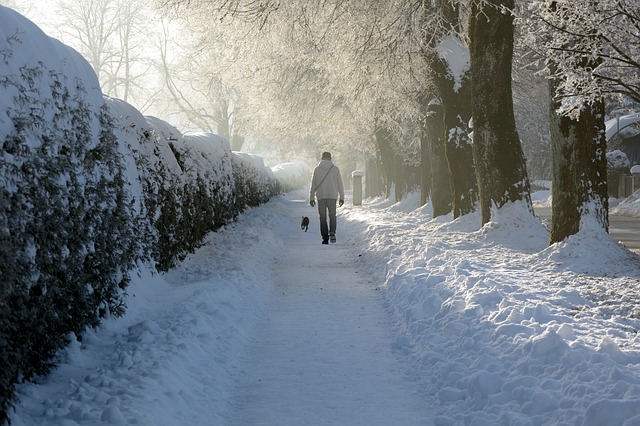|
Listen To The Article
|
You may rather reach for blankets when you look out your window during the cold months, but there are some good reasons to pull on some boots and go for a walk. Cold temperatures and some snow should not stand in the way of enjoying the season and staying healthy.
There are both mental and physical benefits of this cold-weather walking, so grab a friend or two and head outside to experience what walking in the winter has to offer.
Benefits
With the lack of sun in the colder months, walking is a great way to keep your spirits up. Walking reduces stress as more sun equals more serotonin, which helps slow and stop food cravings. Winter walking also helps in weight loss regimes, because you have to work harder when walking through snow (that is, unless you have a sidewalk or clear street).
Walking in the winter, it may come as a surprise, actually helps fight infections. The infection-fighting cells will increase when you go out in the cold.
Walking in colder temperatures makes your body burn more calories than in warm weather. This is because you need to work harder to become and stay warm. Once the blood starts really pumping, endorphins are released, helping you feel great.
The sun gives us Vitamin D, and by walking for just 15 minutes three times a week, you can get enough Vitamin D to help strengthen your bones and other parts of your body. The sun causes your body to produce Vitamin D, so get outside and let the sun shine on you for a while.
Physically, walking improves balance and coordination, lowers blood-pressure and strengthens bones. It also increases energy and encourages better sleep patterns. Inflammation, swelling and joint pain are also reduced.
Mentally, walking improves concentration and acts like an anti-depressant.
Preparation
Of course, we should take precautions when walking in the winter. Know your route and surroundings. Be aware of the terrain. Remember to check the temperature as well. Sometimes taking two or three shorter walks is better than taking one really long one. Yes, sometimes it is just too cold. For the shorter walks, you may have to walk a little quicker than on the long one, but the outcome will be the same.
As with any form of exercise, always check with your doctor before you start. Begin slowly, and build up to your desired walk time. This will allow your body to get stronger and adjust to the cooler weather.
Walk with friends, or at least tell someone when and where you will be walking.
Bring water! Even if it is cold, you will still need to stay hydrated and will get thirsty. Have a warm up and go at a good, comfortable pace. There is no need to race.
Carrying a cell phone is always a good precaution, and you will still need to carry sunglasses and sun block. The winter sun’s strong rays can be deceiving, although warm.
Plant An Entire One Acre Survival Garden
What to Wear on a Winter Walk
Pick good, appropriate footwear. Don’t grab shoes or boots with flat or smooth soles. Put on a pair of well-tractioned boots or shoes, made with non-slip soles.
Put mitts or gloves on and keep your hands moving. Your center of balance is affected when you keep your hands in your coat pockets as you walk.
Wear a hat, scarf and mitts; those items are a must. Wear bright clothing so drivers and other people can see you clearly.
It is a very good idea to wear layers, and make sure your clothing is comfortable, not clumsy or bulky. This way, you can adjust to the workout you are getting from the walk.
Things to Remember
If possible, walk during the first half of the day. Morning and lunchtime is perfect winter-walking weather. You will have plenty of daylight hours and often have the warmest temperatures of the day.
You will need to re-hydrate after your walk, even if you don’t feel like you’ve worked up a sweat. Drink some room-temperature water.
Be aware of frostbite, what it looks like and how to prevent it.
Enjoy your winter walks by being prepared, staying safe and finding joy in your surroundings. It is a great activity to do with the family or with friends. What better way to stay healthy than by doing something fun that you enjoy. Bring a camera — and create some memories along the way.
 Off The Grid News Better Ideas For Off The Grid Living
Off The Grid News Better Ideas For Off The Grid Living




